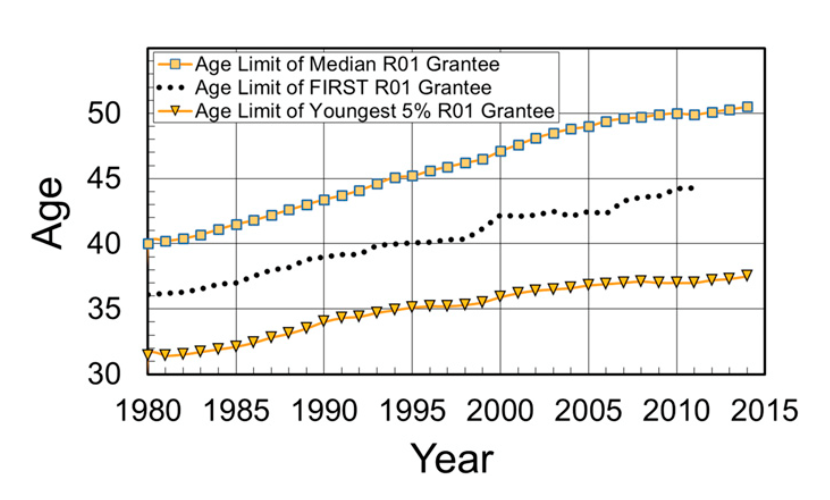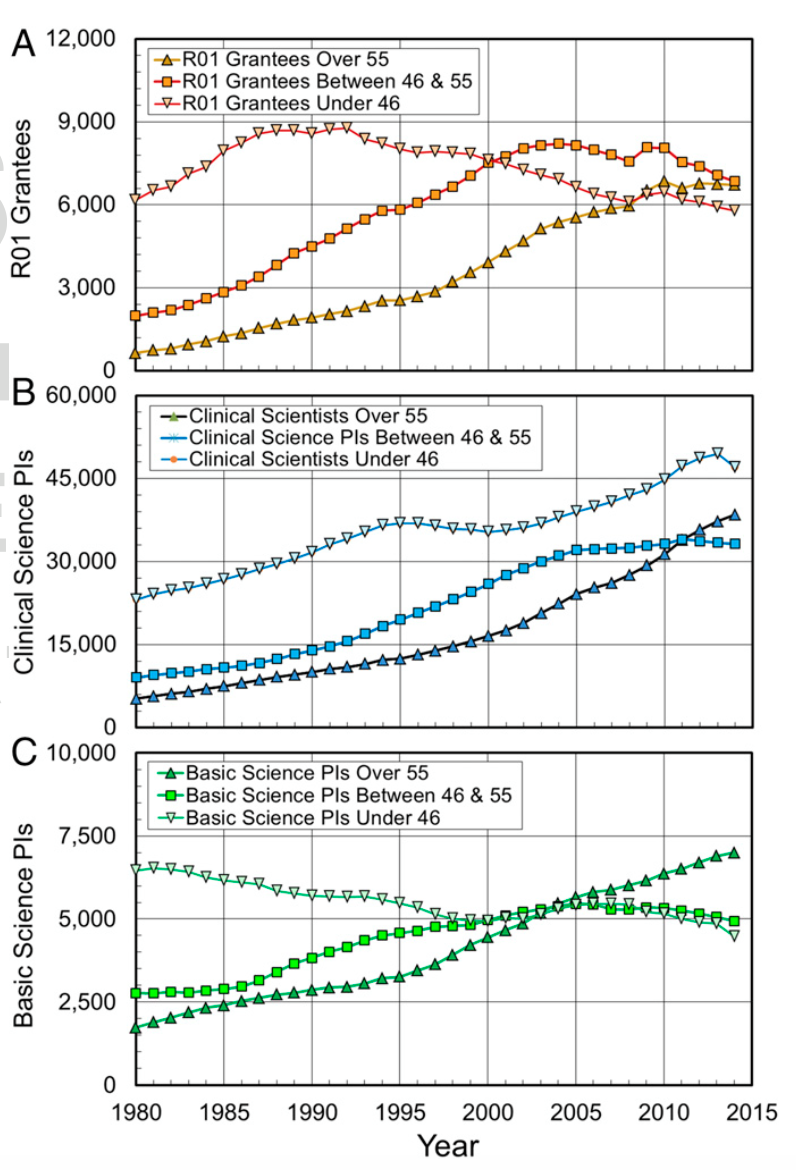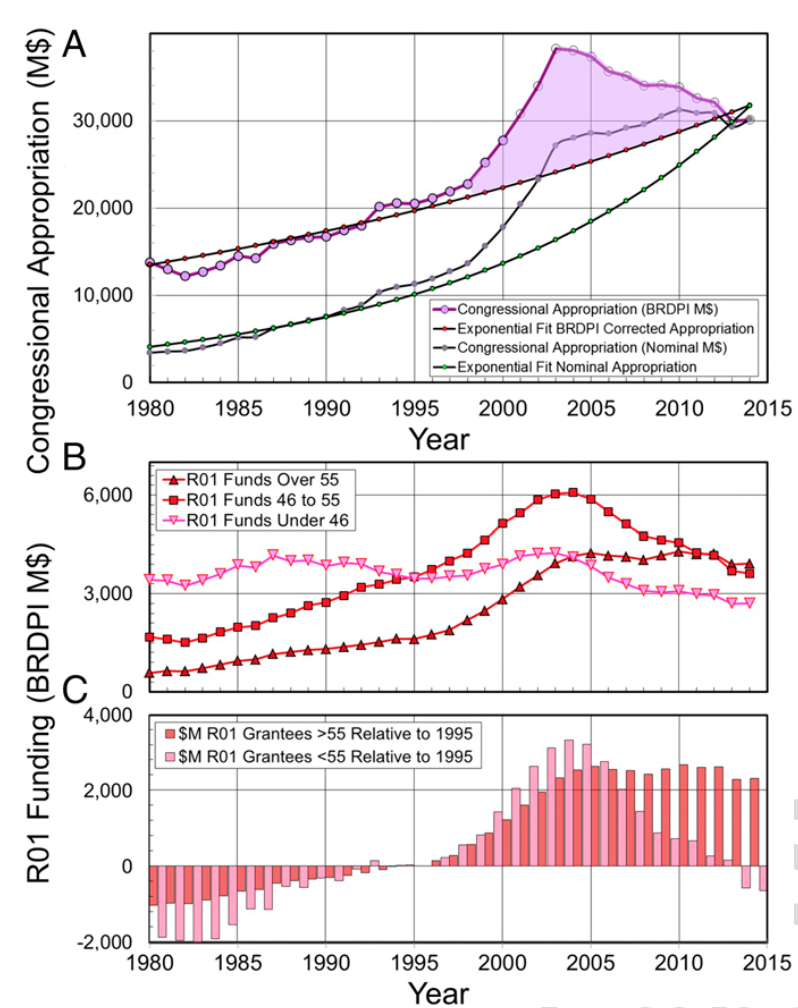You have /5 articles left.
Sign up for a free account or log in.

National Institutes of Health
Young researchers represent the future of science and often make unexpected discoveries. Yet National Institutes of Health grants to principal investigators under the age of 46 have dropped steadily since 1982, according to a new study in Proceedings of the National Academy of Sciences. That’s despite a near tripling of inflation-corrected federal funding for the NIH over the same period, meaning age bias, not scarcity of resources was likely at play, the study says. The PI success ratio, or the fraction of basic-science researchers receiving grants, also dropped for younger scientists (under 46) and increased for those over 55.
The NIH already has begun work to improve the grant outlook for younger researchers, and the new paper suggests such efforts -- namely the Early-Stage Investigator priority policy started in 2008 -- have been successful. Together with the National Institute of General Medical Sciences’ Maximizing Investigators’ Research Award program to reward senior PIs with research time in exchange for less funding, the paper says, these changes “may reverse a decades-long trend of more money going to older PIs.”
The paper also recommends that additional resources be devoted to transitional postdoctoral fellowships already offered by NIH.
“Future of Fundamental Discovery in U.S. Biomedical Research” was written by brothers Michael Levitt, professor of structural biology at Stanford University and, Jonathan M. Levitt, a senior researcher in informatics at the University of Wolverhampton in Britain. They assert that not having a traditional Research Project Grant, or R01 grant, from the NIH isn’t so bad -- as long as scientists are “given the funding needed to work independently and make their new discoveries in fundamental, curiosity-driven, basic-science research.”
The paper notes that a majority of Nobel laureates made their prizewinning breakthroughs before the age of 40 and that many tech CEOs dropped out of college to start their innovative ventures. It focuses on NIH grants because tenured medical school faculty members -- who are most dependent on external funding academic scientists -- receive most of their grants from the institutes.
For their analysis, Levitt and Levitt looked at age variation among R01 grantees. The median age grew from 40 to 50 over the period studied, while U.S. life expectancy grew by just about five years. The average age of first-ever R01 grantees also increased (the black dotted line below).

They also considered age distribution for R01 grantees, clinical science PIs and basic science PIs, finding that the number of R01 grantees under 46 declined over time, as did the number of basic science PIs. The growth rate for clinical scientists over 55 was highest in that group.

To rule out funding changes as a factor in what they observed, Levitt and Levitt studied the relationship between congressional appropriations for the NIH and R01 funding allocations by age. Funding for older R01 grantees increased steadily but dropped for middle-age grantees after 2004 and hardly changed for younger grantees. Since 1995, funds for R01 grantees over 55 increased by $2.3 billion but decreased by $6.5 million for younger grantees.

Levitt and Levitt say it won’t be easy to increase the number of young basic science PIs, but that “new fundamental discoveries made by young PIs in the United States are vital for future breakthroughs in biomedicine.”
They also suggest that post-2008 NIH efforts to support early-career researchers are making a difference, since grant success ratios for PIs under 45 have risen since 2010, to well about the mean level for PIs over all.
“We see no alternative but to increase the [Early Stage Investigator policy], which should be strengthened using an age-related correction,” the paper says, endorsing expansion of the research-release program for senior faculty members, as well. Continued monitoring of the issue through periodic study using anonymized data is important to Levitt and Levitt, too, who “hope that existing PIs over the age of 55 will realize how fortunate they were in their youth and help younger PIs by mentoring them for independence and originality.”
Michael Levitt, a Nobel laureate, has previously described helping young scientists get the opportunities afforded to baby boomers as his "pet project." He said via email that he was optimistic more funds could be directed toward younger scholars, even in era of proposed cuts to the NIH. That’s because as funds become increasingly tight, he said, "proper stewardship is increasingly important.”
“Young people make the breakthroughs that fuel future research,” he added.
Levitt and Levitt make a strong scientific and economic case for supporting early-career researchers. Some research looking beyond Nobel Prize winners suggests age is but a number when it comes to scientific impact, however. Still, many scientists are concerned with the funding climate for their early-career counterparts.
Bruce Weinberg, a professor of economics at Ohio State University who recently published a study suggesting that the science work force is aging due to demographics and the lifting of the mandatory retirement age for academe, said the flow of "resources to young and early-stage investigators is a critical factor in enabling young and early-stage researchers to establish independent careers." So the new results are promising in that there's “some evidence that NIH’s efforts to address the aging of the biomedical research work force are helping,” he added.
The National Academics of Sciences, Engineering and Medicine recently launched the Next Generation Researchers Initiative, another intervention in early-career funding problem. Michael Lauer, deputy director for extramural research for the National Institutes of Health, said at a meeting for the initiative earlier this year that rates for successful grants are going up for those over 60, but down for both early- and midcareer scientists.
Lauer said Monday that "NIH agrees more should be done to support early-career and midcareer scientists," and that it's a topic of active discussion. The new findings offer data-based evidence that the post-2008 early-career policy "is having a positive impact but may not be going far enough in ensuring a robust future generation of productive basic biomedical researchers," he added.
Gary McDowell, a biophysical scientist and resident at Manylabs workspace who advocates for junior scientists as executive director of the nonprofit Future of Research, agreed with the recommendation to put more postdocs on their own K99 fellowships. A “shift of the postdoctoral work force to fellowships would be a way to start trying to make the postdoc a more independent position, like it is intended to be,” he said.
He also pointed out that the proposal to award more R01s to early-career investigators complements current discussions about a possible NIH grant cap. That cap, announced last month, limits the number of R01 grants a single PI can hold to three. About 6 percent of NIH-funded investigators currently exceed that.
“NIH has been acting to address a biomedical research work force dangerously out of balance,” Francis Collins, its director, said in announcing the cap. “While we have made progress in reversing the decline in grant funding to early-career investigators through various programs and policies, the percentage of NIH awards that support this group remains flat.” Unfortunately, “gains for early-career investigators have been offset by a decline in the percentage of NIH awards that support midcareer investigators," he said. "The only group for which the percentage of grant funding is increasing is late-career investigators.”
Moreover, Collins said, “the distribution of NIH grant funding is highly skewed, with 10 percent of NIH-funded investigators receiving over 40 percent of NIH funding. While that might be just fine if the data suggested that this is the best way to get results, analyses conducted by both NIH and others have shown that incremental research output gradually diminishes as the amount of support per investigator increases.”
Highlighting a finding of the new article, McDowell said the aging of the work force “did not have to lead to a decline in PIs under 46, and particularly basic sciences PIs. The system needs to address its own sustainability, and I agree that targeting the way money is distributed is a key way of doing this.”





